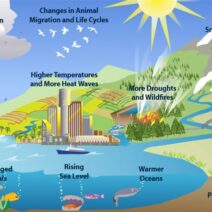Power plants are vital components of modern civilization, providing the electricity necessary to sustain our daily lives, industries, and technological innovations. However, the energy they generate comes at a substantial cost to our planet, particularly through the lens of climate change. Understanding how power plants contribute to global warming requires a deep examination of their operational mechanisms, the types of fuels they utilize, and the overarching implications of their carbon emissions.
To appreciate the role of power plants in climate dynamics, one must first acknowledge that the majority of electricity generation is still reliant on fossil fuels—coal, natural gas, and oil. When these fuels are combusted to produce energy, they release an array of pollutants, foremost among them carbon dioxide (CO2). This greenhouse gas is meticulously documented for its proclivity to trap heat in the atmosphere, thereby leading to global warming.
The carbon intensity of various energy sources plays a pivotal role in this equation. Coal-fired power plants are among the most egregious offenders, emitting approximately twice as much CO2 per unit of energy produced as natural gas facilities. This stark disparity raises critical questions: Why do we continue to leverage such an environmentally detrimental source of energy? The answer lies in its historical ubiquity and the infrastructural entrenchment that makes transitioning away from coal a formidable challenge.
Natural gas, often touted as a ‘bridge fuel’ due to its lower carbon footprint compared to coal, does not come without its own set of environmental dilemmas. While it produces fewer emissions during combustion, the extraction process known as hydraulic fracturing or “fracking” releases methane—a greenhouse gas significantly more potent than CO2 in the short term. Thus, the lifecycle emissions associated with natural gas must be scrutinized to determine its true impact on climate change.
Moreover, renewables such as wind, solar, and hydroelectric power present a promising alternative to fossil fuels. These energy forms generate electricity without emitting CO2 during operation. Nevertheless, transitioning to renewable energy sources is a multifaceted challenge that encompasses technological, economic, and political dimensions. Still, as global awareness of climate change intensifies, the imperative for a swift transition only grows stronger.
Power plants operate under substantial economic pressures. The demand for energy fluctuates dramatically, creating urgency for plants to respond swiftly to consumption peaks. Unfortunately, this responsiveness often translates to reliance on peaker plants—facilities that may utilize oil or natural gas to generate electricity at a moment’s notice. The inherent carbon emissions associated with these temporary structures compound the climate problem, reinforcing the necessity for energy conservation and efficiency measures.
Several innovative strategies have emerged to ameliorate the carbon impacts of power generation. Carbon capture and storage (CCS) technology represents one such approach, aiming to capture CO2 emissions before they enter the atmosphere, effectively allowing coal and gas plants to operate with reduced carbon footprints. However, the implementation of CCS remains economically and technologically challenging, leading many to argue that the emphasis should be placed on scaling up renewable energy technologies rather than retrofitting existing fossil fuel plants.
Integrating energy storage solutions, such as batteries, can help address the intermittent nature of renewables like solar and wind. Enhancing our energy infrastructure to accommodate these technologies is essential for mitigating the reliance on fossil-fuel-powered power plants. The question thus becomes, how can societies effectively investigate and implement these alternatives on a larger scale?
Awareness and education around energy usage are crucial in this context. The average consumer’s choices, such as energy conservation, the adoption of energy-efficient appliances, and participation in demand response programs, can collectively lead to substantial reductions in overall energy consumption and, consequently, lower emissions from power plants.
Furthermore, each locality must thoroughly assess its energy mix and begin to enact policies encouraging an expedited transition towards cleaner energy sources. Governments play an essential role in this transition by providing incentives for renewable energy investments, imposing stricter regulations on existing power plants, and funding research that furthers innovation in sustainable energy technologies.
Public sentiment towards climate change and energy consumption can serve as a powerful catalyst for change. As more individuals become informed about the ramifications of energy production on global warming, they can exert pressure on policymakers and industries to facilitate a shift towards cleaner, more sustainable energy practices. The collective action of environmentally conscious citizens can catalyze a wave of transformation, as seen in various regions around the world where grassroots movements have successfully influenced legislative change.
Ultimately, the relationship between power plants and global warming underscores the necessity for systemic change. While the current energy paradigm is deeply entrenched, recognizing the carbon costs associated with energy production is fundamental for fostering a sustainable future. The stakes are undeniably high; the challenge of modifying our power generation strategies is not merely an environmental concern; it is a matter of social, economic, and political stability for generations to come.
In conclusion, comprehending the complexities surrounding power plants and their carbon emissions sheds light on the broader implications of our energy choices. The interdependence of energy production and ecological stability beckons a re-evaluation of our current practices and encourages a shift towards renewable energy sources. The battle against climate change hinges on our collective ability to rethink our approach to power generation and make informed decisions that respect both our planet and future generations.








